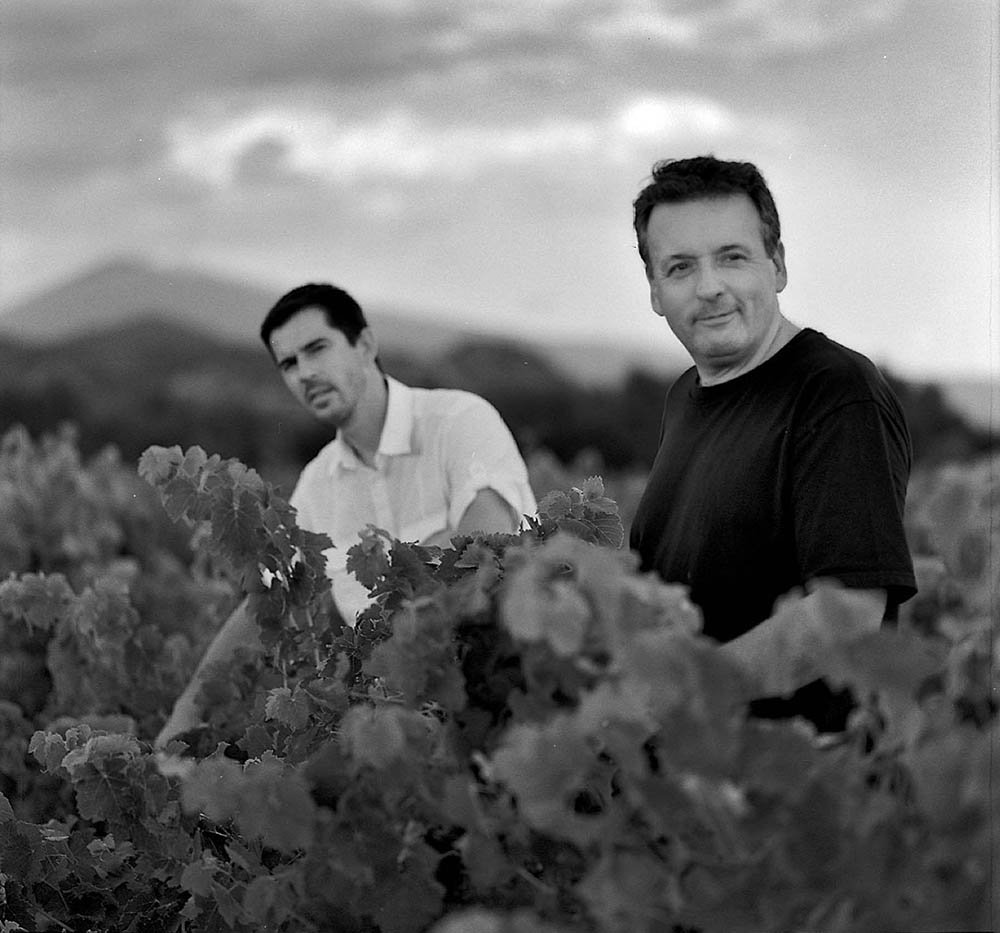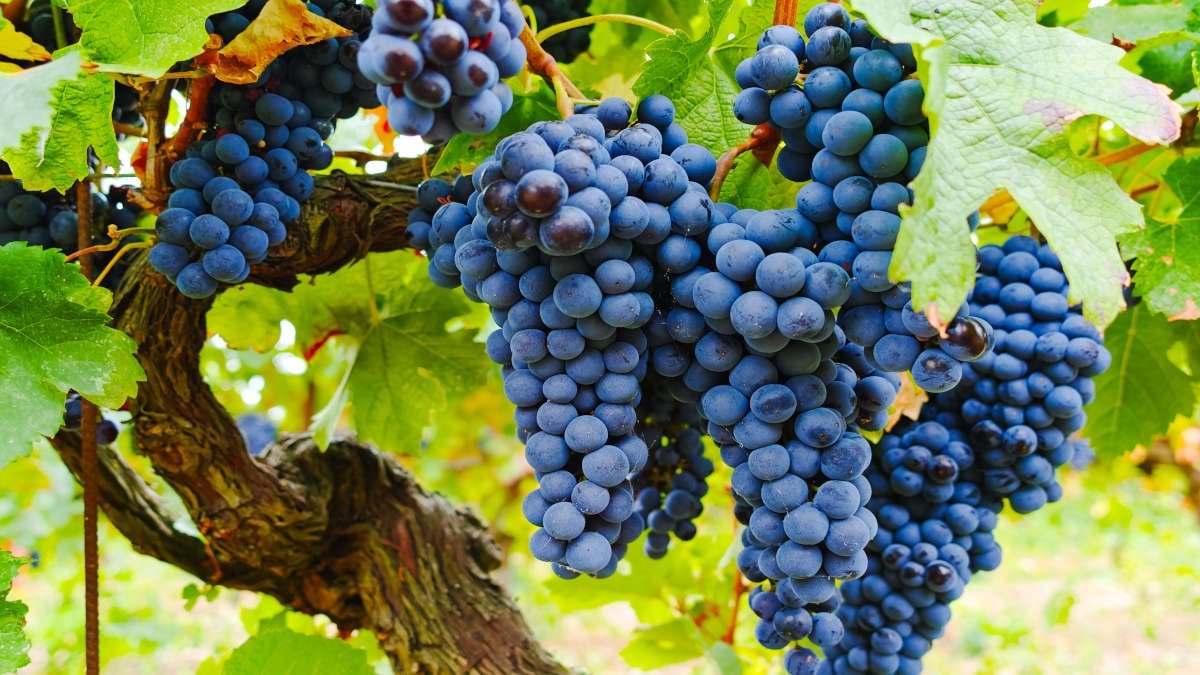France > Rhone > Southern Rhone > Aime Arnoux
organic practices
Les Dentelles de Montmarail, hovering over the vineyards of Gigondas and Vacqueyras
VACQUEYRAS & GIGONDAS
Vacqueyras and Gigondas are two of the best appellations in the southern Rhone. Both are located in the Departement of the Vaucluse, just east of the Rhone River and north of the Durance River. The Vaucluse takes its name from the latin/Roman vallis clausa - “closed valley,” a reference to the cliff-walled valley that envelops the Font de Vaucluse… one of the world’s largest karst springs and the source of the Sorgue River.
The Font de Vaucluse
The Departement is mountainous, including the Dentelles de Montmarail, the looming mass of Mont Ventoux, the Monts de Vaucluse and the Luberon Massif. The mountains are largely limestone and include many caves, sinkholes, and springs.
Located along the southwest foot of the Dentelles de Montmarail, Vacqueyras and Gigondas have been wine producing areas since Roman times. From the Carolingian conquest through the 1800’s much of the area was controlled by the House of Orange (currently the ruling House of the Netherlands). Those territories not part of the County (from 1163 the Principality) were parts of the Compte Venaissin, a papal state that included Avignon, Chateauneuf-du-Pape and the Papal Exclave to the north, within the Departement of the Drome.
First regulated by royal decree in 1737, the district was ncorporated within the Cotes du Rhone appellation at its creation in 1937. Cotes du Rhone is a broad region of 171 communes (legally defined villages) and produces some 415 million bottles of wine annually. Within Cotes du Rhone are some 95 communes designated Cotes du Rhone Villages, a higher level of classification. Within that are a further 18 villages allowed to include the village name below the Cotes du Rhone designation, and finally 17 crus - villages with their own appellation controllee. The 17 are . Beaumes de Venise, Cairanne, Château-Grillet, Châteauneuf-du-Pape, Condrieu, Cornas, Côte-Rôtie, Crozes-Hermitage, Gigondas, Hermitage, Lirac, Rasteau, Saint Joseph, Saint Péray, Tavel, Vacqueyras, and Vinsobres.
Vacqueyras
Vacqueyras was originally part of the Cotes du Rhone created in 1937, elevated to Cotes du Rhone Villages in 1955 and then was finally elevated to its own AOC in 1990. The climate is Mediterranean, with the best wines produced on the upland Plateau des Garrigues, at 1200-1400 ft elevation.
The soils of Vacqueyras are similar to those of Chateauneuf’s - limestone and quartz cobbles in an iron-rich sandy clay base. In fact the name Vacqueyras originates in the latin Valléa Quadreria, meaning Valley of Stones. The lower elevation and more southerly locaton gives Vacqueyras wines a rustic, brighter and higher-toned style. 97% of Vacqueyras production is red. AOC regulations require that the red be made up from at least 50% Grenache, up of at least 20% Syrah and/or Mourvèdre, and the remaining 10% can be any permitted variety, including white varieties in any percentage. The 18 red and white grape varieties permitted in the Vacqueyras appellation are: Cinsault, Grenache Gris and Noir, Piquepoul noir, Brun Argenté, Syrah, Mourvèdre, Muscardin, Terret Noir, Counoise, Carignan, Vaccarese, Clairette (Blanche and Rosé), Bourbelenc, Marsanne, Rousanne, and Viognier. The AOC regulations for Vacqueyras Blanc allow Bourboulenc, Clairette, Grenache Blanc,
Marsanne, Roussanne, Viognier, and require that no single variety can make up more than 80% of the final wine.
Gigondas
Originally founded as a “R&R” town for the Roman Second Legion stationed nearby (and originally named Jocunditas- “place of pleasure,”) Gigondas was one of the first Cotes du Rhone villages to be granted its own AOC, in 1971.
Gigondas vineyards at the foot of the Dentelles
Gigondas is north of Vacqueyras, further upslope and on clay rich soils with limestone cobbles and substrate, and is known for its deep, burly reds. The climate is still Mediterranean but with somewhat cooler nights. No white wine is produced. Gigondas AOC requires that the wines be made from a minimum of 50% Grenache, a minimum 15% Syrah and/or Mourvedre, and a maximum 10% from the other permitted varieties: Bourboulenc, Brun Argenté (local syn. Camarèse or Vaccarèse), Cinsault, Clairette, Clairette Rose, Counoise, Grenache Blanc, Grenache Gris, Marsanne, Muscardin, Piquepoul Blanc, Piquepoul Noir, Roussanne, Terret Noir, Ugni Blanc, and Viognier. Gigondas location in the shadow of the Dentelles limits morning sun, giving the longer hang times so beneficial to producing truly great Grenache.
DOMAINE AIME ARNOUX
In 1717, the Count François de Castellanne, de Lauris, de Vassadel, de Gérard, Chevalier marquis of Ampuis, de Lagneroux, Vacqueyras and its territories universal and direct landlord, gave a vineyard to Pierre Bovis, an ancestor of the Arnoux family. Over the past 3+ centuries, the Arnoux family domain has expanded its holdings to about 85 acres of choice land on the Plateau des Garrigues. In 1936, paterfamilias Aime began contracting with neighbors to expand access to nearby appellations, including Gigondas and Chateauneuf. These wines, made by the Arnoux family for nearly a century, are made with the same care and from vines of the same quality as the family’s personal holdings. Aime was succeeded by his sons Jean-Maris and Régis. Today the the family business is managed by Jean Maris’ sons with Marc and Jean-François.
Jean-Francois & Marc Arnoux
The Plateau des Garrigues’ soils, largely an extension of the geology of Chateauneuf-du-Pape, are iron-rich clay soils with rolled quartz cobbles. The cobbles absorb heat during the day and release it at night, allowing the grapes to achieve ripeness similar to that of it’s more exalted neighbor, Chateauneuf. Domain production from this important terroir represents some of the finest wine of Vacqueyras.
From the ancestral estate of Chateau Lestours Clocher, the Arnoux family produces two main lines- the introductory wines of the Clos du Clocher collection, designed to be simple and user-friendly, and the classic wines of Domaines Aime Arnoux collection- estate wines from the family domain and several properties owned by the family in nearby appellations. These are either labelled as vineyard-designated wines, or as selections parcellaires- individual plots selected to produce the finest possible wines. These wines are produced from sustainably farmed, largely organic vineyards. Terroir represents only the Domaine wines.
The Wines
Cotes du Rhone Rouge “Selection Parcellaire:” This wine, from old vines of 65% Grenache and 35% Syrah, is a smooth and elegant take on Cotes du Rhone. Limestone/marl soils with large cobbles. Vinified and finished in a mix of large oak foudres and second-year barriques. Pure and clean with poise and balance.
Ventoux Rouge “Domaine de Gouredon:” (This is the former AOC Cotes du Ventoux- the name was changed in 2008.) From organic vineyards on the plateau of Saint Hyppolyte de Graveyron on limestone rich sandy marl soils. A blend of Grenache, Syrah, Carignan, Mourvedre & Cinsault in perfect harmony resulting in a bright and fresh wine with notes of red fruit and dessert spices, and a long, generous finish.
Vacqueyras Blanc “Selection Parcellaire:” a blend of Grenache Blanc, Viognier, Bourboulenc, Marsanne, Roussanne & Clairette. The blend varies from year to year depending on harvest conditions. Fermentation is initiated in stainless, then finished in oak. Elevage 9-12 months in new oak after fermentation.
Vacqueyras Rouge “Domaine la Font du Chene:” 75% Grenache, 25% Syrah from certified HVE (high environmental value) vineyards. Deep flavors of cherry and spices with a long succulent finish.
Gigondas “Domaine de Maurelle:” 70% Grenache 30% Syrah from a vineyard on the lower foothills of the Dentelles, on sandy marl soils. The location provides intensely concentrated fruit with deep notes of cherry and the sweeter spice notes of the garrigue. The finish is long and savory with intense minerality.
Grenache vines, courtesy The Wine Society
“At its simplest grenache makes round, heart-warming wines. At its best it has real majesty, making full-bodied wines with a sensation of sweetness due to the amount of alcohol and glycerol. It can become complex and spicy, with flavours reminiscent, some say, of rich fruit cake.”
Geology of Gigondas









